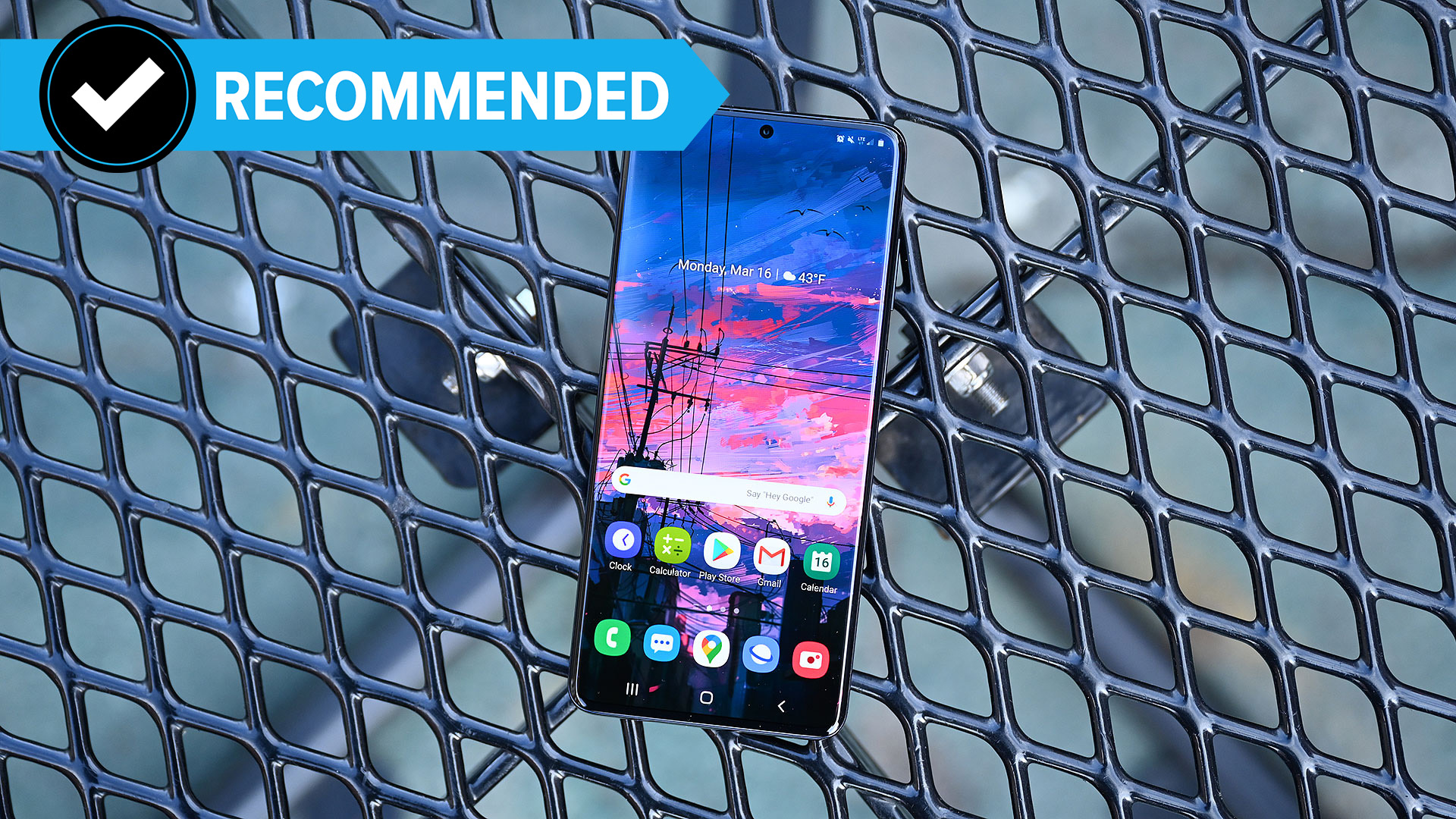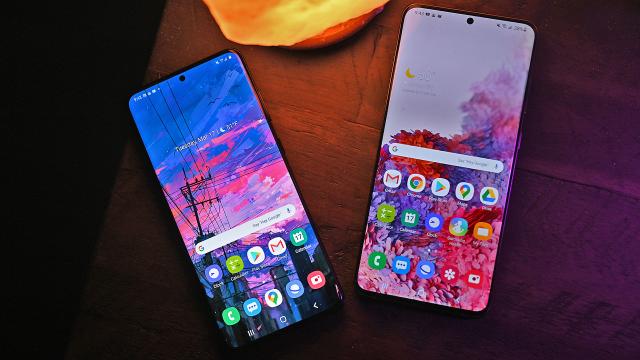After checking out the Galaxy S20 Ultra, it’s difficult to forget its brawny build, avalanche of specs, and the impressive reach of Samsung’s Space Zoom. Unfortunately, at $1,999, it’s also a bit too expensive to love. At that price, the S20 Ultra has to be head and shoulders better than every other phone on the market, and it just isn’t.
But perhaps the best argument against the S20 Ultra is the existence of the S20+, because for a bit over 20 per cent less money, the S20+ delivers 95 per cent of what you get from its more expensive sibling. So if you’re looking for a high-end Android phone with tons of bells and whistles, the S20+ is the one to get.
Starting with its build, the Galaxy S20+’s 6.7-inch screen isn’t that much smaller than the 6.9-inch panel on the S20 Ultra, so you’re not really missing out on much when it comes to your overall viewing experience. And because the S20+’s camera module isn’t a huge, boxy thing that sticks out like a ravenous overbite, it’s lighter, sleeker, and much more suited to one-handed operation too.

Galaxy S20+
What is it?
Samsung's 6.7-inch flagship phone
Price
$1,499 (8GB/128GB), $1,649 (12GB/128GB + 5G) or $1,899 (12GB/512GB + 5G)
Like
Superb build quality, excellent battery life, massive 12GB of RAM, possibly the best display on the market.
Don't Like
No headphone jack, shorter zoom than S20 Ultra, camera smoothing a bit too aggressive, cheaper than S20 Ultra but still very expensive.
As for its display, the S20+ still has support for a 120Hz refresh rate (but only at FHD+ resolution, mind you), which when combined with an excellent peak brightness of 729 nits and incredibly vivid colours, there’s absolutely no compromise in image quality. In fact, the only phone in recent history with a display that comes anywhere near matching the S20+’s screen is the Oppo Find X2, which isn’t officially available in the U.S. and costs around $US1,350 ($2,335). Also, like the standard S20 and S20 Ultra, the S20+ features slightly less rounded sides, which reduces distortion around the edge of the screen while still providing an extremely comfortable and polished in-hand feel (and IP68 water-resistance).
The S20+ doesn’t fall short on specs either, boasting the same Qualcomm Snapdragon 865 chip, 12GB of RAM, 128GB of base storage (or 512GB if you go for the optional upgrade), and microSD card slot you get on the S20 Ultra. The only thing you’re really missing is the built-in headphone jack found on last year’s Galaxy S10. Although since 3.5mm jacks are becoming an increasingly rare feature, it’s not like the S20 is really losing ground there either.
Editor’s note: In Australia, Samsung mobile devices come with an Exynos chip instead of the Snapdragon so performance results may vary.
[referenced url=”https://gizmodo.com.au/2020/02/samsung-galaxy-s20-plus-ultra-australian-price-release-date-specs/” thumb=”https://gizmodo.com.au/wp-content/uploads/2020/02/samsung-s20-3-410×231.jpeg” title=”Samsung Galaxy S20 Phones: Australian Price, Specs, Release Date” excerpt=”The first Samsung Unpacked for 2020 is now in the bag. With it comes the new Samsung Galaxy S20 range which has three phones (and a lot of variants) – the S20, S20+ and S20 Ultra. Thanks to yet another leaky boat, we weren’t surprised by the specs, but now they’re all shiny and official. We have all the details right here for you, including when you can get them in Australia and how much they cost.”]
I also want to call special attention to the 12GB of RAM in the S20+. Putting that much memory in a phone might seem as silly as Scrooge McDuck trying to swim through a pool of coins (which would be physically impossible btw), but after using the S20 Ultra and now the S20+, I’ve really grown to appreciate having access to that much RAM. That’s because by clicking on the icon of an app in Android’s recent apps list, you can select up to three different apps that the phone will always keep running in the background for instant multitasking, something that even works with more resource-intensive things like games and editing apps. So despite the incredibly powerful A-series chips Apple uses in iPhones and iPads, I’d argue the S20+’s mountain of RAM makes it faster in the real world, with tests like this helping support that hypothesis.
Next we come to cameras, which is the really the only main point of difference between the S20+ and S20 Ultra. As someone who uses a phone’s zoom camera way more than its ultra-wide cam, I sometimes find myself longing for the 10x lossless zoom from the S20 Ultra. However, even with just a 3x lossless zoom (which doesn’t even use a true optical zoom to achieve that reach), the Galaxy S20+ compares quite favourably to the Pixel 4’s 2x telephoto camera and Google Super Res Zoom, with the S20+ often producing the better looking zoom pic.
In a shot of New York City at 3x, the S20+’s photo is slightly sharper, resulting in crisper text on various signs (see below), while the Pixel 4 XL using its 2x optical zoom lens and digital Super Res Zoom processing to get to that full 3x produced an image that looks just a tiny bit softer, darker, and fuzzier.
And in more typical shots, while the S20+ doesn’t earn a clean sweep over the Pixel 4 or iPhone 11, thanks to its slightly cheaper price tag, the S20+’s few photo shortcomings—like sometimes making certain textures look a bit too smooth or too yellow—are much more forgivable. Like previous Galaxy phones, the S20+ tends to overemphasize yellows and sometimes struggles with white balance—especially at night—which is something you can see in head-to-head comparison of a shot I took of a tree sitting underneath a streetlight. That said, thanks to brighter, more vivid colours, the S20+ produced a more appealing pic of some nearby graffiti than both the iPhone 11 and Pixel 4.
[referenced url=” thumb=” title=” excerpt=”]
Meanwhile, when things are really dark and you need to use the S20+ dedicated Night Mode, the S20+ produced a surprisingly bright and relatively detailed image of a basketball court that almost looks like it shot at sunset instead of midnight, which was when I actually snapped the pic. That said, both the S20+ and iPhone 11’s shot go heavy on the yellows and browns with the iPhone’s shot almost looking like Apple automatically applied some kind of sepia filter, both of which stand in contrast to the Pixel 4’s much clearer Night Sight shot. Google still has the best night mode around.
And just like the S20 Ultra, the S20+ has 8K video capture, Samsung’s new multi-photo Single Take feature, and even a time-of-flight sensor on back for more accurately measuring the size and distance of nearby objects.
And when it comes to battery life, the S20+ fared the best out of all the S20s on our video rundown test, lasting nearly 16 hours (15:56 to be exact) on a single charge. That’s better than the S20 Ultra and the standard S20’s time of 14:41 and 15:16 respectively. Though it’s important to note that if you do enable Samsung’s 120Hz mode, that tends to knock off three to four hours of runtime. Considering that S20+’s impressive longevity, that isn’t really an issue.
Then, when it comes time to recharge, the S20+ supports 25-watt wired charging (which is the same as the S20 Ultra unless you spend extra to buy a separate 45-watt charger), along with 15-watt Qi wireless charging and 9-watt reverse wireless charging, with the latter remaining one of the most underappreciated features on phones.
Also, while 5G support shouldn’t be your top deciding factor when it comes to buying a phone right now (carriers still have a lot of work to do to build out coverage), it’s important to note that that unlike the standard S20 (which currently only supports sub-6GHz 5G), the S20+ supports all three major 5G bands used in the U.S. So even if you don’t live in an area that has 5G coverage right now, the S20+ is already prepared for when you will, which makes it slightly more future proof than the vanilla S20.
Look, I still wish the S20+ (and the S20 Ultra for that matter) was slightly cheaper, and for people who like a smaller phone, the standard S20’s design and dimensions are sublime. In a more sensible world, the $1,649 S20+ would only cost $200 more than the standard S20 ($1,349), and the S20 Ultra would cost $1,799 instead of $1,999. Regardless, the S20+ is a superb device with the best value and blend of specs and features out of the S20 family. And among Android phones, the S20+ is the real high-end handset to beat. Just remember, if you’re thinking about getting one, try to find a deal or trade-in to make that sticker shock just a bit more tolerable.
README
-
Unlike current versions of the standard S20, the S20+ includes support for all three flavours of 5G (sub-6GHz, mid-band, and mmWave).
-
The S20+’s 3x lossless zoom isn’t quite as good as the S20 Ultra’s 10x lossless zoom, but it’s a lot less bulky too.
-
I still wish Samsung would add an option to enable 120Hz mode at the phone’s full resolution, instead of limiting 120Hz to FHD+.
-
The S20+ comes with Android 10 with Samsung’s One UI 2.1 running on top.
-
Try to find a deal or trade-in if you can, because while the S20+ is $350 cheaper than the S20 Ultra, forking over $1,649 for a phone is still kind of painful.
